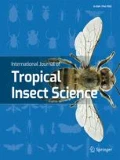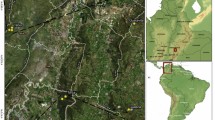Abstract
Mounds are prominent architectural features found in savannah ecosystems, where they play important roles. Although constant in form for many species, the appearance and type of mound can vary with environmental conditions such as rainfall, temperature, vegetation and locality. However, variability between mounds of same species in different habitats like savannah is not well studied. Here we compared the densities and architectural designs of mounds built by seven species of mound building termites found in two different savannah habitats. A low diversity (Shannon diversity index) was obtained for the Sahel compared to the Sudan region. Simpson’s diversity shows 64% and 67% chances of encountering any two of the species from Sahel and Sudan savannah respectively. Within species, there were no main difference in height, basal circumference and width of mounds except for the mounds of Macrotermes bellicosus. Commonly built mounds by the species were cathedral, cone, dome and mushroom shapes. The differential response to the two savannah types by the termite’s species suggest varying ability to respond to environmental selection pressures. Fungus growing termite, like Odontotermes, might have to trade mound modifications due to the environmental condition against mound structure beneficial to fungus growth.


Similar content being viewed by others
References
Aanen DK, Eggleton P (2005) Fungus-growing termites originated in African rain forest. Curr Biol 15:851–855
Adam RA, Mitchell JD, van der Westhuizen MC (2018) The role of the harvester termite, Trinervitemes trinervoides (Termitidae: Nasutitermitinae) in semi-arid grassland ecosystems of South Africa: abundance, biomass and grass consumption. African Entomol 26:36–44
Adamson A (1943) Termites and the fertility of soil. Trop Agric (Trinidad) 20:107–112
Aiki I, Pirk C, Yusuf A (2019) Thermal regulatory mechanisms of termites from two different savannah ecosystems. J Therm Biol 85:1–7
Alexander L, Allen S, Bindoff NL (2013) Working group I contribution to the IPCC fifth assessment report climate change 2013: the physical science basis summary for policymakers. OPCC
Bottinelli N, Jouquet P, Capowiez Y, Podwojewski P, Grimaldi M, Peng X (2015) Why is the influence of soil macrofauna on soil structure only considered by soil ecologists? Soil Tillage Res 146:118–124
Brossard M, López-Hernández D, Lepage M, Leprun J-C (2007) Nutrient storage in soils and nests of mound-building Trinervitermes termites in Central Burkina Faso: consequences for soil fertility. Biol Fertility Soils: Cooperating J Int Soc Soil Sci 43:437–447
Campora CE, Grace KJ (2004) Effect of Average Worker Size on Tunneling Behavior of Formosan Subterranean Termite Colonies. J Insect Behavior 17(6) C 2004:17–15
Collins MN (1979) The nests of Macrotermes bellicosus (Smeathman) from Mokwa, Nigeria
Collins NM (1981) The role of termites in the decomposition of Wood and leaf litter in the southern Guinea Savan. Oecologia (Berl) 51:389–399
Cornelius ML, Osbrink WL (2011) Influence of dry soil on the ability of Formosan subterranean termites, Coptotermes formosanus, to locate food sources. J Insect Sci 11:162
Dangerfield JM, Veenendaal EM, Riddoch BJ, Black H (1992) Termites and land use in south-East Botswana: variety and abundance of termite surface features. Botswana Notes Records 24:165–179
Danks HV (2002) Modification of adverse conditions by insects. Oikos 99:10–24
Darlington JP (1988) The structure of mature mounds of the termite Macrotermes herus in Kenya. Int J Trop Insect Sci 9:339–345
Davies AB, Levick SR, Asner GP, Robertson MP, Rensburg BJV, Parr CL (2014) Spatial variability and abiotic determinants of termite mounds throughout a savanna catchment. Ecography 37:852–862
Deblauwe I, Dibog L, Missoup AD, Dupain J, van Elsacker L, Dekoninck W, Bonte D, Hendrickx F (2008) Spatial scales affecting termite diversity in tropical lowland rainforest: a case study in Southeast Cameroon. Afr J Ecol 46:5–18
Eggleton P, Bignell DE, Sands WA, Waite B, Wood TG, Lawton JH (1995) The species richness of termites (Isoptera) under differing levels of Forest disturbance in the Mbalmayo Forest reserve, southern Cameroon. J Trop Ecol 11:85–98
Erpenbach A, Wittig R (2016) Termites and savannas–an overview on history and recent scientific progress with particular respect to West Africa and to the genus Macrotermes. Flora et Vegetatio Sudano-Sambesica 19:35–51
Field M, Duncan F (2013) Does thermoregulation occur in the mounds of the harvester termite, Trinervitermes trinervoides (Sjöstedt)(Isoptera: Termitidae)? African Entomol 21:45–57
Gouttefarde R, Bon R, Fourcassie V, Arrufat P, Haifig I, Baehr C, Jost C (2017) Investigating termite nest thermodynamics using a quick-look method and the heat equation BioRxiv: 161075
Harris WV (1956) Termite mound building. Insect Soc 3:261–268
Jeltsch F, Weber GE, Grimm V (2000) Ecological buffering mechanisms in savannas: A unifying theory of long-term tree-grass coexistence. Plant ecology 150:161–171
Jones D, Susilo F, Bignell D, Hardiwinoto S, Gillison A, Eggleton P (2003) Termite assemblage collapse along a land-use intensification gradient in lowland Central Sumatra, Indonesia. J Appl Ecol 40:380–391
Joseph G, Seymour C, Coetzee B, Ndlovu M, De La Torre A, Suttle R, Hicks N, Oxley S, Foord S (2016) Microclimates mitigate against hot temperatures in dryland ecosystems: termite mounds as an example. Ecosphere 7:e01509
Jouquet P, Dauber J, Lagerlöf J, Lavelle P, Lepage M (2006). Soil invertebrates as ecosystem engineers: intended and accidental effects on soil and feedback loops
Jouquet P, Guilleux N, Shanbhag RR, Subramanian S (2015) Influence of soil type on the properties of termite mound nests in southern India. Appl Soil Ecol 96:282–287
Kemp PB (1955) The termites of North-Eastern Tanganyika; their distribution and biology. Bull Entomol Res 46:113–135
Korb J (2010) Termite mound architecture, from function to construction. Springer, Heidelberg
Korb J, Linsenmair KE (1998a) The effects of temperature on the architecture and distribution of Macrotermes bellicosus (Isoptera, Macrotermitinae) mounds in different habitats of a west African Guinea savanna. Insect Soc 45:51–65
Korb J, Linsenmair KE (1998b) Experimental heating of Macrotermes bellicosus (Isoptera, Macrotermitinae) mounds: what role does microclimate play in influencing mound architecture? Insect Soc 45:335–342
Korb J, Linsenmair KE (2000a) Thermoregulation of termite mounds: what role does ambient temperature and metabolism of the colony play? Insect Soc 47:357–363
Korb J, Linsenmair KE (2000b) Ventilation of termite mounds: new results require a new model. Behav Ecol 11:486–494
Korb J, Kasseney BD, Cakpo YT, Casalla Daza RH, Gbenyedji JNK, Ilboudo ME, Josens G, Meusemann K, Ndiaye AB, Okweche SI (2019) Termite taxonomy, challenges and prospects: West Africa, a case example. Insects 10:1–8
Lee KE, Wood TG (1971) Termites and soils. Academic Press, London
Lüscher M (1956) Die Lufterneuerung im nest der termite Macrotermes natalensis (Haviland). Insect Soc. 3:273–276
Lüscher M (1961) Air-conditioned termite nests. Sci Am 205:138–145
Mando A, Brussaard L (1999) Contribution of termites to the breakdown of straw under Sahelian conditions. Biol Fertil Soils 29:332–334
Meyer V, Braack L, Biggs H, Ebersohn C (1999) Distribution and density of termite mounds in the northern Kruger National Park, with specific reference to those constructed by Macrotermes Holmgren (Isoptera: Termitidae). African Entomol 7:123–130
Mitchell BL (1980) Report on a survey of the termites of Zimbabwe
Netshifhefhe SR, Kunjeku EC, Visser D, Madzivhe FM, Duncan FD (2018) An evaluation of three field sampling methods to determine termite diversity in cattle grazing lands. African Entomol 26:224–233
Noirot C, Darlington JPEC (2000) Termite nests: architecture, regulation and Defence. In: Abe T, Bignell DE, Higashi M (eds) Termites: evolution, sociality, symbioses, ecology. Springer Netherlands, Dordrecht
Ola-Adams BA, Iyamabo DE (2009) Conservation of natural vegetation in Nigeria. Environ Conserv 4:217–223
Pearce MJ (1997) Termites, biology and pest management. Ecology, Willing Ford United Kingdom
Pomeroy DE (1977) The distribution and abundance of large termite mounds in Uganda. J Appl Ecol 14:465–475
Pringle RM, Doak DF, Brody AK, Jocqué R, Palmer TM (2010) Spatial pattern enhances ecosystem functioning in an African savanna. PLOS Biol 8:1–12
Ruelle JE (1970). Revision of the termites of the genus Macrotermes from the Ethiopian region (Isoptera: Termitidae). Brit Mus Natur Hist Bull Entomol:365–444
Sands WA (1965) A revision of the termite subfamily Nasutitermitinae (Isoptera, Termitidae) from the Ethiopian region. Bull Br Mus Nat Hist Entomol (Suppl 4):1-172
Sands W (1992) The termite genus Amitermes in Africa and the Middle East (NRI bulletin 51)
Shanbhag RR, Kabbaj M, Sundararaj R, Jouquet P (2017) Rainfall and soil properties influence termite mound abundance and height: A case study with Odontotermes obesus (Macrotermitinae) mounds in the Indian Western Ghats forests. Appl Soil Ecol 111:33–38
Sinervo B, Mendez-De-La-Cruz F, Miles DB, Heulin B, Bastiaans E, Villagrán-Santa Cruz M, Lara-Resendiz R, Martínez-Méndez N, Calderón-Espinosa ML, Meza-Lázaro RN (2010) Erosion of lizard diversity by climate change and altered thermal niches. Science 328:894–899
Sunday JM, Bates AE, Kearney MR, Colwell RK, Dulvy NK, Longino JT, Huey RB (2014) Thermal-safety margins and the necessity of thermoregulatory behavior across latitude and elevation. Proc Natl Acad Sci 111:5610–5615
Team RC (2018) R: A language and environment for statistical computing. R Foundation for statistical computing, Austria
Thomas CD, Cameron A, Green RE, Bakkenes M, Beaumont LJ, Collingham YC, Erasmus BF, DE Siqueira MF, Grainger A, Hannah L (2004) Extinction risk from climate change. Nature 427:145–148
Turner JS (2004) Extended phenotypes and extended organisms. Biol Philos 19:327–352
Uys V (2002) A guide to the termites genera of of southern Africa. Plant Protect Res Instit Handbook:1–116
Willmer PG (1982) Microclimate and the environmental physiology of insects. In: Berridge MJ, Treherne JE, Wigglesworth VB (eds) Advances in insect physiology. Academic Press
Wood T, Johnson R, Bacchus S, Shittu M, Anderson J (1982) Abundance and distribution of termites (Isoptera) in a riparian forest in the southern Guinea savanna vegetation zone of Nigeria. Biotropica 14:25–39
Acknowledgements
We thank Prof. Robin Crewe, Jannette Mitchell and colleagues from the Social Insects Research Group (SIRG) for their valid discussions and contributions to this work. We also thank Prof. Judith Korb and Prof. Guy Josens for providing the keys used for the identification of Macrotermes and Cubitermes to species level. Funding for this research was provided in part by: The University of Pretoria, The South African National Research Foundation (NRF) Incentive Funding for Rated Researchers (IFRR) to CWWP and AAY, Y-Rated Research Grant and Alexander von Humboldt’s Georg Foster HERMES Experienced Research Fellowship (grant nos. 3.4-NGA-1164298, ZAF-1164298 –GFHERMES-E) to AAY. IPA was supported by University of Pretoria Postgraduate Bursary and the Nigerian Tertiary Education Trust Fund (TETFund).
Author information
Authors and Affiliations
Corresponding author
Additional information
Publisher’s note
Springer Nature remains neutral with regard to jurisdictional claims in published maps and institutional affiliations.
Rights and permissions
About this article
Cite this article
Aiki, I.P., Yusuf, A.A. & Pirk, C.W.W. Refuge in architecture: mounds and diversity of termite species from a Sahel and Sudan savannah. Int J Trop Insect Sci 41, 1365–1371 (2021). https://doi.org/10.1007/s42690-020-00330-5
Received:
Accepted:
Published:
Issue Date:
DOI: https://doi.org/10.1007/s42690-020-00330-5




